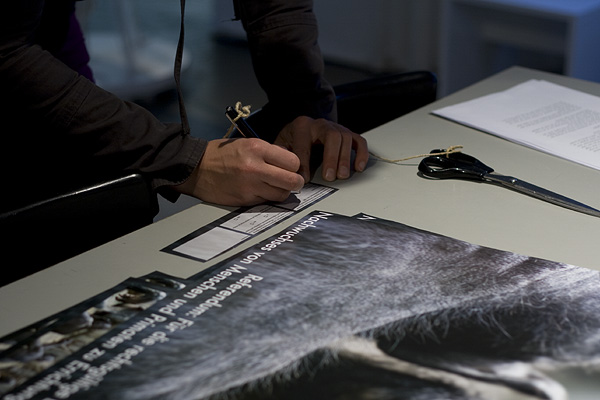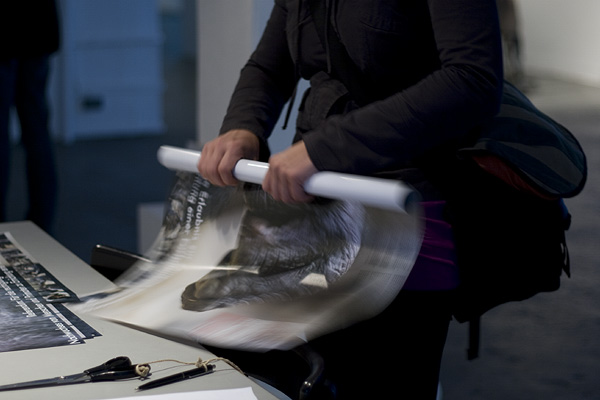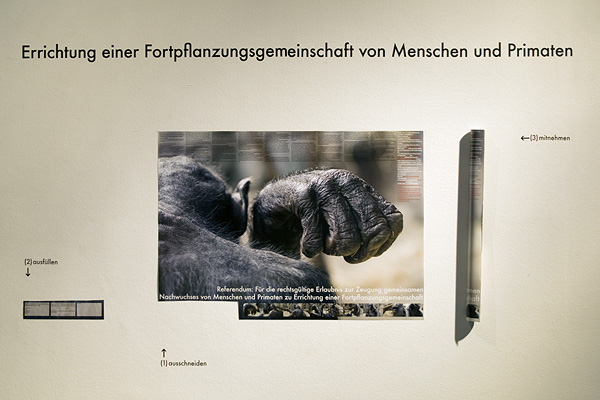ngbk, neue gesellschaft für bildende kunst, berlin





das ausstellungsprojekt beschäftigt sich mit auflösungs- und werdensprozessen animalischer und menschlicher identitäten auf der theoretischen grundlage des konzepts vom tier-werden, wie es deleuze und guattari in tausend plateaus formuliert haben. matysik richtet in diesem rahmen eine art informationszentrum ein, das seine recherchen zum thema zugänglich macht. mit plakaten ruft er zur aktiven beteiligung an der abstimmung zur änderung des embryonenschutzgesetzes der bundesrepublik deutschland entsprechend seines referendum-entwurfs (s. 09.06) auf.
the exhibition project looks at processes of disintegration and creation of animal and human identities, based on the theoretical concepts of becoming an animal, as formulated by deleuze and guattari in thousand plateaus. within this framework matysik establishes an information center, where his research on this topic is made available. by use of placards he calls for active participation in the vote to change the law protecting embryos in germany, which corresponds to his concept for a referendum (see 09.06).
research on and the creation of hybridity represents an important focus in reiner maria matysik’s work. the three works on display refer – at sociological, ethological and genetic levels – to various phenomena of becoming animal or becoming human and each have models in cultural history and the history of science. the video “feral child,” which shows a young woman naked in the jungle, takes as its model the half-mythical reports of feral children who were raised by animals and, following their entry into civilization, continued to display animal behaviors and in this way undermined the romantic concept of the “noble savage.”
the second video, “junge und affe” [boy and monkey], takes as its starting point a famous study by a married american research couple whose film material matysik uses as footage and rearranges. in 1931 and 1932, the kellogg’s raised the baby chimpanzee, gua, together with their own son, donald, in order to see what developmental differences exist between monkeys and humans when they experience the identical upbringing. the chimpanzee is ideally suited for a fundamental interrogation of the border between human and non-human animals, as it’s genotype is approximately 95 percent the same as human. this genetic proximity may – along with ilya ivanov’s notorious attempts at crossbreeding humans and apes in the early 1920s – have provided the inspiration for the third part of matysik’s work: a plea in the form of posters and questionnaires through which the artist seeks people who, in the service of science, are willing to offer their services as a parent for a monkey-human hybrid.
as a “mad” scientist who has already created a furor with organic plastic and the creation of “future lifeforms,” in a new version of his much-liked “hoax,” matysik plays here with the vague fears people have of a science which answers only to itself as well as with the naïve expectations of healing which are connected with progress in the life sciences. rumors still circulate today that such experiments take place successfully behind closed doors. and yet despite the fact that an entire zoo of transgenetic animals has long existed in various research facilities, such attempts at crossbreeding are, in general, officially condemned as unethical.
the two examples of humans becoming animal as well as animals becoming human, which matysik has selected and newly-interpreted for his films, both investigate the role of heredity and socialization in identity formation or for an individual becoming human or becoming animal. above all, however, the poster with its pseudo-scientific appeal upsets the human self-image and raises questions as disturbing as they are current.
jessica ullrich

